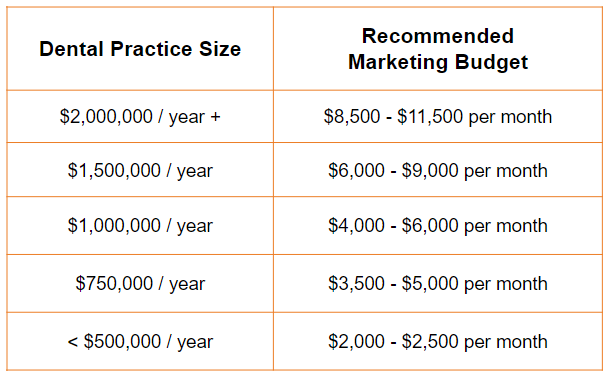
How To Use Your Dental Marketing Budget To Attract New Patients
We’ve all heard the cliche, “You have to spend money to make money”. While it has become an often-overused phrase, it doesn’t make it any less true. Especially when it comes to creating a dental marketing budget that works.
But where should you start?
If you've never considered formalizing a dental marketing budget for your practice, creating one can seem confusing and overwhelming.
According to The Bureau of Labor Statistics, 20% of small businesses fail in their first year, and 50% of small businesses fail in their fifth year.
This means many privately owned dental practices won't be around in 5 years, which in turn means:
- Fewer retirement options for dentists and staff
- Dentists having to work longer hours over the next several years just trying to survive
- Smaller profits and even smaller paychecks
This is why investing in marketing is vital to your dental practice’s growth and success.
Based on our 10+ years working with dentists in different markets across the US and Canada, we know that executing an effective dental marketing budget is key to every dental practice’s success.
Your Dental Marketing Budget: Where To Start
Online marketing is here to stay, but how much money should you be spending on it?
More importantly, how can you make sure the money you spend is actually working to attract new patients?
Your dental marketing budget should be consistent with your practice's growth goals. If you want to aggressively grow your dental practice, that will require a higher dental marketing budget.
If you want to test the waters or aren’t sure what the competition in your market looks like, a slow-growth path with a more conservative dental marketing budget might be the best choice.
A Customized Approach To Every Dental Marketing Budget
The important thing to remember when it comes to creating a dental marketing budget is that there is no one-size-fits-all approach. You might have to spend $3,000/per month to get the results you want while a competitor might need to spend more or less.
A new dental practice in town might need to spend $5,000 or more per month to get the same results you do at $3,000.
However, just because there isn’t a 100% guaranteed “one size fits all” solution to determining your marketing budget, doesn’t mean we’ll leave you without the tools you need.
Below is a chart to help you get started. Take a look at your desired revenue and match it with a basic budget recommendation.
Think about your dental marketing budget the way you encourage your patients to think about their oral health.
A patient may choose a dental practice in town that doesn’t have the best reputation if it means they get to spend less money up front.
However, we all know what happens in just a few months time. The filling falls out or there are problems with the implant. That patient then calls your office for an emergency dental appointment.
In the long run, this patient will spend more time, money and stress on a problem that could have been avoided. They should have done their research and invested in a high-quality dental practice from the beginning.
The same is true of dental marketing.
As tempting as it can be to cut corners on your marketing budget, spending less doesn’t actually save your practice anything. Keep in mind that there is a cost for a lack of new patients each month. You’re likely losing them to your competitors down the street.
"I know the initial price tag for marketing can seem high. But remember - on average every $1 I spend with Firegang, I get at least $10-$15 back! I would do that all day long...and actually, I am doing it all day long."
Daniel Morrissey, CEO - Magic Smiles
You can try to budget too conservatively and save a few dollars today. However, you know you’ll be better off investing an appropriate amount into your dental marketing budget to make sure it actually works to attract those new patients you need.
What do the experts say?
The Small Business Association suggests 7-8% of your revenue should go toward marketing, if your annual revenue is less than 5 million.
At Firegang, we usually recommend our clients spend at least 5-7% of their revenue on a strategic marketing budget.
However, if you’re in a competitive area and want to dominate your market you should plan to budget 10%.
Like I said earlier, there is no “one size fits all” answer.
It's Not Just About The Money
A lot more goes into creating a marketing budget that will work for your practice than simply calculating 6% of your revenue.
Financial planning should be a big part of your marketing budget, but it isn’t the only factor to consider.
Your marketing budget should include 2 factors: finances AND marketability factors. Marketability factors play a huge role in attracting new patients and should be considered when creating your budget.
Remember, when a dental practice becomes more marketable it becomes easier for that practice to attract new patients consistently.
Here are a few things you can do to get your practice on the road to optimal marketability:
Consider staying open until 7pm instead of closing at 5pm. Or offer weekend appointments. According to a survey run by DentistryIQ, extended office hours during the week are important to 57% of those surveyed and nearly half of patients look for dentists offering weekend hours!
Invest in tracking your calls and dental front office training. What good does it do to spend money to attract a new patient if your staff fails to book them when they do call? By tracking your phone calls you can tell which marketing efforts are working. Not only that, you can also see where your staff could use more training.
Invest in dental ppc and Facebook ads for dentists. You have to show up where patients are looking, and while most dentists think patients aren't looking for dentists on Google or Facebook, our data-driven integrated marketing formula proves differently. Ads are one of the most important parts of your dental marketing, and when done right, can help you scale your practice quickly.
Invest in creating a website for your dental practice that isn’t just “pretty”. Most dentists want dental websites that are aesthetically pleasing, but remember: pretty websites don’t necessarily convert visitors to new patients. Work with dental marketing company to design a website designed to turn visitors into new patient phone calls and appointments.
Marketing Tools: Calculate Your Return On Investment (ROI)
Return on investment (ROI) is a measure of the profit earned from each investment. Like the “return” (or profit) that you earn on your portfolio or bank account, it’s calculated as a percentage.
Return - Investment / Investment = ROI
ROI is typically represented by a percentage so just multiply your total by 100.
ROI calculations for marketing campaigns can be complex because you will have many variables on both the profit and the investment sides. However, understanding this formula is essential if you want to produce the best possible results with your marketing investments.
Marketing Tools: Calculate Your Customer Lifetime Value
You can also use the Customer Lifetime Value (CLV) equation as a measurement to determine your ROI.
CLV, or the average lifetime value of a dental patient, is a measure of the profit generated by a single customer (in this case, a single dental patient) or set of customers over their lifetime with your dental practice.
Average Annual Value x Lifelong Relationship = Customer Lifetime Value (CLV)
For Example: Let’s say a new patient’s average annual value is $1,000 (the national average) and the lifelong relationship is about 8 years. That means your customer lifetime value is $8,000.
Once you have that information, you can make informed decision on how much of your revenue to spend on a marketing budget designed to attract dental patients.
Use Your Marketing Budget To Guarantee Your Practice’s Growth
Let's say a dental practice wants to get to $1 million in annual revenue, and is currently experiencing annual revenues of $750,000. Creating a dental marketing budget is essential to reach that goal.
If you use the Customer Lifetime Value calculation, you can determine exactly what you need to do to get there.
Example: For this example, let's use the national average, and say a new patient's first year value is worth $1,000. If you want to grow the practice by $250,000 annually, that means you need to see approx. 250 more new patients in one year. To break that down even further, divide by 12 and you get 21 more new patients per month. That means you're looking to increase the revenue of your practice by $21,000 per month. That's your target.
Avoid The Pitfall Of "Saving" Money On Your Budget
Dental practices often think that they’re saving money by not spending an appropriate amount of their revenue on dental marketing. That's completely incorrect.
Think about it this way: To continue on the example above, if you're looking to grow your practice from $750,000 to $1 million annually, then we know you're going to need to add $21,000 in additional revenue each month. What would you be willing to spend each month on marketing in order to do so? If you choose to take the cheap route, you may struggle to get there. Many doctors will expect to see $21,000 in additional revenue each month while only spending $500/mo on marketing. There's no marketing in world that will return a 42 to 1 ROI.
Your practice can’t grow the way you need it to without making a calculated, yet impactful, investment in dental marketing. By not investing an appropriate amount in your marketing, you're handing new patients over to your competitors each month.
Review your marketing options with a strategic approach focused on helping your practice to reach its overall growth goals.
Remember, successful dental marketing is not an overnight success story. However, once you set up an appropriate dental marketing budget, you'll start to see the growth and ROI you need.
Need help creating a customized dental marketing budget?
Click here to schedule your no-obligation dental marketing assessment call with our team today!
This post was originally published in December 2016 and has been updated to include the latest dental marketing information.

